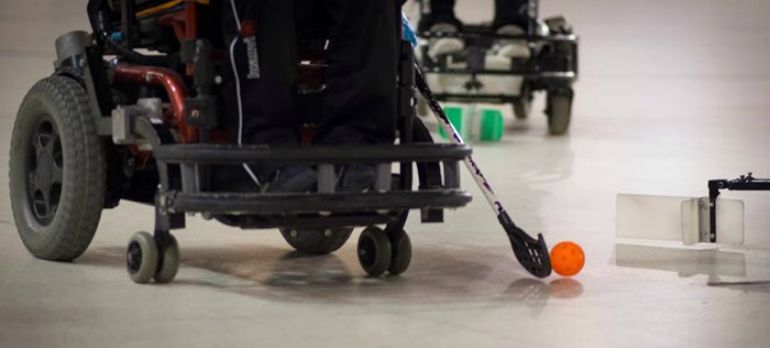Share:
Take it offline!
This Education in Motion resource is also available as a printable PDF.
Download PDF
Wheelchair hockey: how and where to practice it
Although it is not considered a well-known sport on our shores just yet, disability hockey is one of the adapted sports with the greatest appeal. One of its great advantages is that it is a team sport which can be practised by people with different degrees of disability, making it into an integrating and social activity, especially for those with severe disabilities.
Basic rules for disability hockey
The aim of adapted hockey is just the same as those of hockey in any other format: to put the ball (or puck) into the opposing goal and to stop the opposing team from doing the same. However, it does require a greater degree of adaptation, given that it is played using powered wheelchairs and can be practised by people with various disabilities.
Adapted hockey teams are made up of four outfield players and a goalkeeper, with two halves each lasting twenty minutes with a ten-minute break to separate them at half time.
The first distinctive feature of wheelchair hockey is that the playing field is similar to that of an indoor football pitch (measuring approximately 24 x 12 metres) with an external boundary lined by 20cm high boards that prevent the ball from going out of play. The corners must be rounded.
The goals in adapted hockey are lower than those in traditional hockey (measuring 20cm, as with the boundary) and have a double net to prevent the ball from bouncing, so that players with a fixed stick can control the ball at all times.
Another of the more distinctive features of wheelchair hockey is that there are two types of players: those with a manual stick (similar to but lighter than a conventional hockey stick) and those that use a T-stick, which is a T-shaped hockey stick attached to the wheelchair's footrest and is used by players who are unable to hold a manual stick.
The ball is made from a synthetic material and is perforated in order to reduce its weight. It is also designed in such a way as to immediately retain its shape should it be run over by a wheelchair.
If you would like to know more about the rules for wheelchair hockey, about the specific features of the chairs used to play it, about the hockey sticks or any other aspects of the game (fouls, penalties, etc.), you can find further information by consulting the international guidelines for wheelchair hockey (also known as Powerchair Hockey).

Who can practice wheelchair hockey and what are its benefits?
Wheelchair hockey can be practised by anyone regardless of their disability, as it is designed for powered wheelchair users.
The wheelchairs can be adapted in terms of their speed, whilst other aspects of the game can be modified, such as the stick length or the inclusion of additional security such as seatbelts, making it a safe sport for both children and adults.
It can be practised by men and women regardless of age, including those with severe disabilities such as neuromuscular diseases, cerebral palsy, poliomyelitis, hemiplegia, tetraplegia or spina bifida.
Although it still something of a fledgling sport in the UK, England Hockey has a dedicated page for Flyerz Hockey, with a number of resources and success stories for clubs that have set up across the country.
Flyerz Hockey is promoted by England Hockey as a gateway into the sport for people with disabilities, with success stories in places such as Wakefield and Brighton & Hove, encouraging both children and adults to play.
As a team sport, adapted hockey requires its members to meet for training sessions, allowing them to build a team bond that helps build relationships outside of the immediate family environment. Team sports also help promote teamwork and organisational skills, reinforcing a sense of responsibility and coexistence, which often translates into a greater sense of autonomy for people with disabilities.
Disability hockey clubs and associations in the UK
Wheelchair hockey currently has official federations in eleven countries, with each responsible for organising its own national competitions. The IWAS Committee For Powerchair Hockey governs the sport at an international level, as well as several other sports for people with disabilities, a full list of which can be found on their website.
There are also six Ice Sledge Hockey clubs with active teams across England and Wales in Manchester, Cardiff and Sheffield, as well as Basingstoke, Kingston and Peterborough.
Do you love sport? On the Sunrise Medical blog we also have other articles on different sports such as adapted basketball or wheelchair tennis. If you would like to practice any of these sports with the best equipment, at Sunrise Medical we have a line of sports wheelchairs that can all be personalised through Built-4-Me to tailor yours to your game. Let us help you to find the best one to fit your favourite sport!